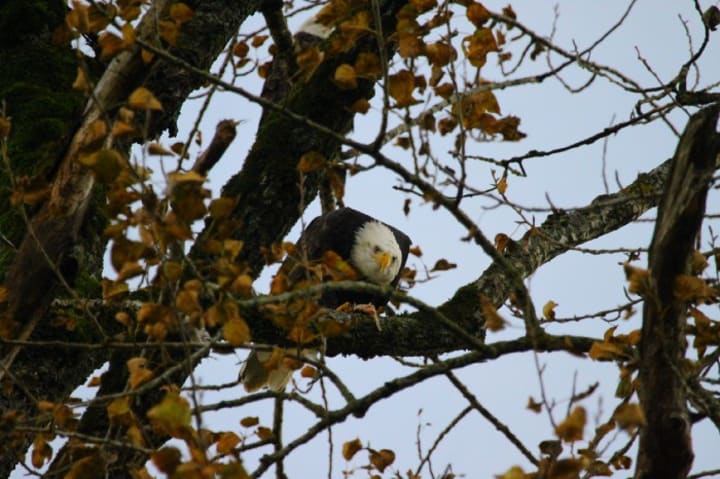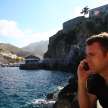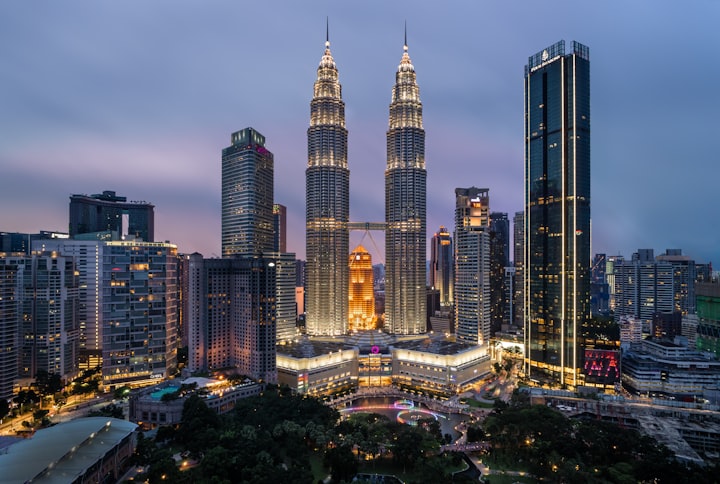When the Wilderness Looks Back
Photographing bald eagles in British Columbia

A branch cracked above me
A noise trees make in winter. Shriveled leaves rattle to the northern wind. Branches turn brittle once the sap stops flowing. North of here, it gets so cold that trees explode. I moved to the warmest part of Canada for a reason.
I looked up. Fallen trees kill around 100 people in the US every year. In Canada, we have far fewer people. But we have a lot more trees.
But the tree wasn’t falling. No branch had snapped. All the way up the laddered branches of the cottonwood, the tallest tree on this side of the river, bright smears of excrement painted the mossy bark. The tree was festooned with eviscerated fish, long strings of vertebra dangling like necklaces pinned by some kind soul to a noticeboard at the head of a trail.
Four hunched shapes sat darkly in the tree like forest spirits. Eagles.
The first time I came, there was almost nothing here
Empty lots marked out by bright surveyor’s flags. Squat soil stacks rising like subterranean snorkels from between tussocks of frosted grass. The roads were already laid out, the black tar looping in cuneiform characters through an empty field.
The first time I saw it, it was familiar. I was raised by a single father. If I got sick or injured at school, badly enough that they needed to send me home, my dad would pick me up and take me to whatever construction site he was working on.
Sometimes, I’d sit in his trailer office and stare uncomprehendingly at architectural plans. I learned to drive a digger when I was thirteen, manipulating the rubber-coated levers in an X pattern with both hands to make the heavy steel bucket rise and fall. Wet cement and brick dust pull me out of wherever I am the minute I smell them and plunge me back twenty-five years to those long-vanished sites.
Cleared of trees except for the lonely strip along the banks of the river, the subdivision was just waiting for the houses to come and the people to follow. But before they did, the eagles were here.
They’ve been here forever.
Bald eagles have been around for at least a million years. Unique to North America, they specialize in hunting fish. And there’s no greater prize than the annual salmon run. Millions of fish swim into the rivers of the West Coast from the Pacific Ocean, drawn by the irresistible urge to reproduce.
The eagles know they’re coming. As the rivers start to freeze with the onset of winter, ice moving slowly southward in a series of signed agreements, the eagles converge. In their thousands, they come to this broad river, the Chehalis mudflats off the Harrison River in British Columbia. Depending on who you ask, it may be the largest gathering of eagles in the world.
Until around 15,000 years ago, they had the place to themselves. They shared it with the salmon and the crows and the geese and even the seals that swim up from the distant ocean, chasing the spawning fish. But one year, humans came down from the north too, traveling slower than the eagles but just as determinedly. Fifteen thousand years later, they keep coming.
When I first found this place, I was still growing
The eagles have to wait five years or so to develop the distinctive white head and tail that makes them so easy to spot and so difficult to photograph in bright sunlight. We wait a full quarter-century for the complex architecture of our brains to settle into place, our risk management and long-term planning capabilities finally maturing even as our reactions decline.
It was around the time I bought my first apartment, following the real estate crash of 2008. I finally had a job I could see myself doing for more than six months. The river was swarming with fish. The space between the mountains was filled with opportunity, and all I had to do was reach out a taloned hand and pull whatever I wanted from the clear cold stream.
No more construction sites. No more wet cement. My grandfather worked construction because he had to. My father did it because his father did. He wanted something better for me. Finally, I thought I had it.
I zoomed in
Raising my camera toward the sky, I focused on the eagles in the cottonwood tree. Through the precise glass, I watched them breathe. I could almost see the bright life burning inside their four-chambered hearts, an avian prototype of our own.
But even with a three pound lens that turned my head into that of some cycloptic monoceros as I scanned the tree, I couldn’t see as well as the birds. In the lazy late sunlight, they spread dark wings and tore apart salmon and peered right through me.

Something happens when a wild animal looks you in the eye. Something quiet but massive, the silent halls of the ocean opening up inside your chest.
They live in a different world than we do. A world without words, where nothing matters except action. A world without mercy, without consolation. Swimming lazily under the water one minute, the next, you might find yourself pierced by black talons and lifted into the airless sky.
It would be childish to call it cruel. Cruelty requires knowledge. Birds and beasts don’t know enough to be cruel. The best and worst they can aspire to be is efficient.
We don’t live in the same world the eagles do. But it’s their world, not ours, that’s real.
Maybe I’ll never look at these photos again
Every year, interrupted only by the two years I spent traveling Europe, far away from this river and these forests, I come to watch the eagles. My hard drive is overflowing with pictures of them. Sometimes, its taking the photo that matters. Not preserving it.
The last remaining scrap of forest echoes to their high giggling cries. Their white heads shine upside down in the surface of the water, before a sudden plunge tears the reflection apart. Made flamboyant by abundance, they dance in the sky, gripping one another’s talons and plummeting toward the ground before breaking at the last minute to climb the sun-streaked ladder of the air once again.
Courting couples toss chunks of fish to one another. Rivals battle on the beaches and jostle for position at the very top of the tallest trees still standing.
And every year, the subdivision sprouts more houses as dead leaves sprout mold. Ten years ago, I parked wherever I liked and made my way to the river over open ground. Now, cookie-cutter McMansions sit right next to one another, and the few lots not currently occupied already sprout the timber skeletons of the houses that will soon be complete.
Here, they don’t build in brick the way my father used to. But the smell of wet cement is the same, strong enough to be picked out over the reek of rotting salmon.
These giant birds don’t exist where I grew up, and the first time I saw them, they became a dramatic symbol of the new world I found myself in. A world wider and wilder and grander than the one I came from. Purer somehow. Less corrupted by the withering touch of humanity.
These places can’t last. And I know I’m part of the problem. Every time I encounter an eagle or a bear or the single heart-stopping occassion I saw a mountain lion, I know I’m helping to habituate these animals to people.
And people are animals too. Eagles build nests that weigh a ton, and only the strongest trees can support them. The whole world is buckling under our weight.
We have the same right to food and air and water that the eagles do, that the salmon do, that the trees covered in eagle shit and fish guts do. But I love this place less with every hastily-built house that gets thrown up to capitalize on a decades-long real estate boom that also made me rich. Hate the game.
Eagles do what eagles do, and people do what people can. We are all hunting for something, just below the shining silver skin of the water. Something we can grasp and hold and take with us as we beat heavy wings in the direction of the sun.
© Ryan Frawley 2020.
About the Creator
Ryan Frawley
Towers, Temples, Palaces: Essays From Europe out now!
Novelist, entomologist and cat owner. Ryan Frawley is the author of many articles and stories and one novel, Scar, available from online bookstores everywhere.






Comments
There are no comments for this story
Be the first to respond and start the conversation.